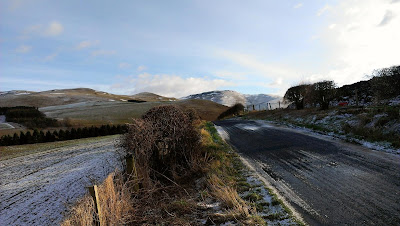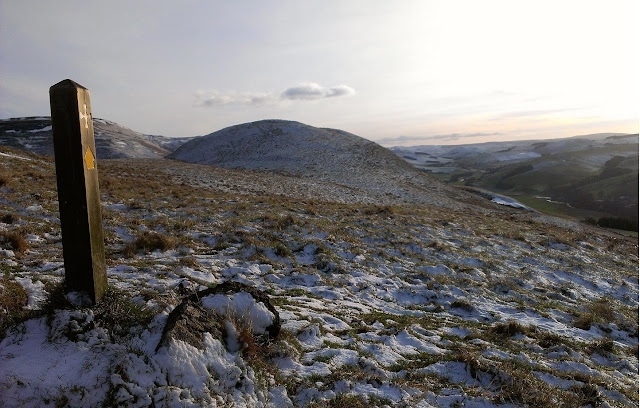Distance: 32 miles (51.5km)
Ascent/Descent: 1170m/1140m (less 100m & 1mile if you omit Eildon "Mid Hill")
Start/Finish: Melrose to Kirk Yetholm
Terrain: Muddy trails, some (very quiet) roads
Transport: First buses, and Munro's buses. Berwick-upon-Tweed is stop on main East coast train line, with shuttle buses to Lindisfarne (Mon - Sat)
Route: Route Map
St. Cuthbert's Way Stages: 1 [2] Next
Summary
Although a low-level route, its fair to say I underestimated the terrain underfoot - and dragging a bike along would be a pain in the @rse, for me at least. I also underestimated how nice it is, expecting to be spending most of the journey trudging along the rough edges of samey fields. As well as fields there are great rivers, dells, pretty villages, woodlands, moorlands, abbeys, churches, monuments, castles, forts, country parks and country pubs with fire places...
Blog
 |
| Melrose Abbey |
The idea to spend this weekend exporing the St. Cuthbert's Way occurred just Friday morning, when I discovered the "Met. Office"
had filled the map of scotland with sun symbols for all of Saturday. Well I
couldn't let this historic event pass - especially as it had been a wee while since I
last headed to the trails. For the right reasons really, with lot's of
stuff needing done (like moving home for example!), but at last I was
going to get back to the real world.
Although the decision had been spontaneous I had looked into this route a few months ago, planning to split
the run at Kirk Yetholm thus fitting it nicely into two of Winter's short
days. There's a bus to Melrose Saturday morning from Edinburgh, and a
train home from Berwick-upon-tweed not too far from the finish at
Lindisfarne, but I was gratefully saved from working around public
transport when my dad phoned up about something completely unrelated, I
told him my intentions, and later he got back to me saying he was "allowed to go".
 |
| Looking W from the 422m top of Eildon Mid Hill (a bonus option!) |
Saturday morning was stunning as promised. The car
indicated 0-degC outside, and patches of slushy ice lined the sides of
the A68. It wasn't expected to get much warmer than that today so I
hoped the freezing temperature would keep all the trails nice and firm.
(Nope).
I parked in the tidy centre of Melrose, from where we walked the
short distance to the abbey and found a nearby cafe in which to take
refuge from a bitterly cold breeze. That breeze would be my tailwind
for the day.
 |
| The way ahead (snowy Cheviots on horizon) |
My dad drove off to Kirk Yetholm, planting my "drop bag" en-route at a
lay-by where the St. Cuthberts Way crosses the main road to Kelso. Then
he'd be free to do his walk up in the Cheviots - an area neither of us
had explored. Meanwhile I was jogging up Dingleton Road in search of my
first St. Cuthbert's Way marker/sign. It directed me to run through
the wall of someone's house. A bit further on and there were steps
heading down then up through trees and onto the steep slopes of the
Eildon Hills, then fences were guiding me up between fields and into
gorse and heather, running on semi-frozen mud which was a bit greasy but
no dramas. Apart from that first sign, this was a great start to a long distance path - straight up onto hills
renowned for their extensive views. I was soon upon the saddle of the hills looking over the St. Cuthbert's countryside, with the
snow-caked Cheviots - my eventual destination today - looking very, very
far away! In spite of this I couldn't resist taking a detour and
climbing to the top of nearby Mid Hill, well worth the extra effort.
 |
| Following Bowden Burn towards the R. Tweed |
Returning to the saddle, I descended carefully down the ice-glazed
hillside into some nice woodland, said hello to a couple of horses in a
field, crossed a burn then back up through another wooded hillside
before arriving at the very tidy village of Bowden. Then down to the
Bowden Burn, following a cute track along a dell, which wasn't so cute
later on where it had been churned up by horses and I could barely walk
never mind run. That's why I was quite glad to reach tarmac road downhill to
Newton St. Boswells, signs directing me on a zig-zag course amongst back-yards and eventually down to the Bowden Burn again, which was followed to its confluence with the Tweed.
The next mile or so was along the banks of the majestic river. I found
the trail surprisingly hard going, lots of steps cutting up and down the
wooded embankment, and between the steps was more of that greasy mud. I probably should have expected this having heard the reports from runners of the inaugural "Three Peaks
Ultra Marathon" back in October, which followed this part of the route.
 |
| A series of steps interspersed with mud along the banks of the River Tweed |

Up another wooded dell into St. Bowswells (presumably the "Oldtown" version)
then back down to the river to entertain golfers. This next stretch reminded me so much of last year's
"Thames Trot 50" race which happened to be taking place again today. Memories of frosty, river-side scenes
.
 |
| Maxton Church (dedicated to St. Cuthbert) |
I left the Tweed at Maxton Church (dedicated to St. Cuthbert) and
shortly after began the long boggy and very linear tramp up "Dere
Street". With roads like this its no wonder the romans never got past
the Firth of Forth. Too stubborn to "go around" hills or obstacles.
Excusing the pun, the St.Cuthberts Way religiously follows the roman road for at least 6 miles. After 4 of
them I was begging for a corner, but there was stuff to keep me amused. On the hill to my left was a concrete tardis. A bit further on, another hill had
a concrete phallus Waterloo Monument. And after more mud, gorse, and iced-over puddles I came to
"Lilliard's Stone".
 |
| Lilliard's Stone, with Dere Street going on, and on, and on.. |
|
The way eventually crosses a road and enters a dense plantation, dipping into another nice dell on its way South into Harestanes Country Park. The mud-strip circumnavigates this before arriving at another great borders river - the Teviot. Now there are plenty signposts for this walk but you can't rely on them alone -
when the mud track reaches the river, follow the mud to the
right, which leads you through the trees towards a left turn for a fine
suspension bridge which takes you to the mud on the other side. To be fair this next bit wasn't bad, grassy for at least half a mile as the route doubles back on itself along the
river's southern bank before turning South to find the Kelso road, and my cue to find the drop-bag my dad had planted at a lay-by.
Sitting on the old railway platform here, munching on a banana, I contemplated how slow I was moving today, with only 17miles done and 14 to go.
Sure this wasn't a race or time trial, nor was there any particular need to rush, it just felt like more
effort to move forward than almost all other, much hillier routes I've done. Couldn't blame the (tail) wind, so was it the amount of under-foot grease? Or inside-belly grease!? It hadn't
been long since Christmas, but I can't put all the blame on Terry's chocolate orange.
 |
| "Please shut the gate". Footbridge over Oxnam Water beyond |
The way continued South, roman style, leaving Dere Street after a mile
uphill
where a fingerpost sent me NE down a shelter-belt and out onto tarmac.
It was a brief stint up a hedge-lined road before being routed off
into woodland then down to a bridge over Oxnam Water.
 |
| Cessford Castle and remaining bit of wall |
Sitting having a breather on the grassy hill above the burn, I noted that those distinct Eildon Hills, which seemed to have been stalking me since Bowden, were finally dropping away into the distance. Very soon I was about to get another indication of my progress towards the white Chieviots - little speckles of snow where the sun hadn't hit the steep tarmac hill to the South of Oxnam Water. A I progressed East, there were more lingering sprinkles of white, first in the shadows of hedges along the road, then lots more up the sides of another wooded dell, and after that, a dusting along the side of a stone wall between fields as the way climbed. When I crested this hill the Cheviots re-appeared and were suddenly very close.
 |
| Road after Morebattle |
I stood here to admire the view for a moment, looking from Cessford moor with
Cessford castle below. Perhaps the fastest four miles of the journey followed - farmtrack then tarmac, down to and around the castle, then beyond to the quaint village of Morebattle where the pavements were dusted white and the roads dipped into pools of slush.
I looked longingly at the
Templehall Hotel thinking of warmth and a pint, but knew I'd enjoy it all the more once safely arrived at Kirk Yetholm, hopefully before dusk.
 |
| Overlooking the valley of Kale Water |
Even though the final 7 miles between Morebattle and Kirk Yetholm involved proper hills (you know what I mean), I found this bit much easier going then the muddy riverside paths earlier, and the 6 miles of roman swamp. The route up "Grubbit Law" - what a great name - starts with a footbridge over Kale Water, and so the road is left behind and its time to meet some cows. I showed them the respect they deserve by walking not running through their field, and those blocking my path politely moved aside.
 |
| Waymarker on Wideopen Hill |
From here it was up and over Wideopen Hill, where a happy group of walkers asked me to take their picture, and pointed out the sign indicated this was both half way and the highest point of the St. Cuthbert's Way (a mere 368m, how easy to underestimate this journey!). From here it was a fun descent down the broad grassy ridge, following the line of the Cheviots NE, down into the glen that shelters the Yetholms. I was glad to have arrived before sunset, and was glad to find my dad still in the bar with the rugby on. Plastered in mud though I was, the shower could wait for a bit.
To be continued..
St. Cuthbert's Way Stages: 1 [2] Next





 Up another wooded dell into St. Bowswells (presumably the "Oldtown" version)
then back down to the river to entertain golfers. This next stretch reminded me so much of last year's
"Thames Trot 50" race which happened to be taking place again today. Memories of frosty, river-side scenes.
Up another wooded dell into St. Bowswells (presumably the "Oldtown" version)
then back down to the river to entertain golfers. This next stretch reminded me so much of last year's
"Thames Trot 50" race which happened to be taking place again today. Memories of frosty, river-side scenes.







No comments:
Post a Comment